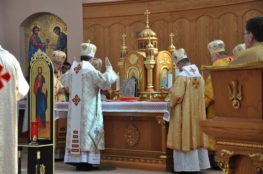It seems to me that it seems to be a commonplace tale around the (online?) Eastern Catholic water cooler which goes something like this. Up until the late 16th Century, Eastern Orthodox living in the area of what is now Ukraine and Belarus were living fine and happy with their perfect Byzantine liturgy, apophatic theology, and mystical spirituality before the big, bad Jesuits stormed in; duped bishops and laity alike; and inaugurated one of the greatest ecclesiastical heists in history, the Union of Brest (followed 50 years later by the Union of Uzhhorod). The inevitable fruits of the “Unia” — so the story goes — was a loss of the “pure Byzantine tradition” coupled with the onset of forced Latinizations. Without getting into the messy history surrounding Brest (which, I should add, was not orchestrated by the Jesuits nor aimed at destroying the Byzantine Rite), I wish so many of these contemporary naysayers of the “Unia” who love to spend their free-time disparaging Latin devotions which they seem to know very little about would spend a few minutes with Fr. Peter Galadza’s excellent study, “Seventeenth-Century Liturgicons of the Kievan Metropolia and Several Lessons for Today,” 56 St. Vladimir’s Theological Quarterly 73 (2012).
In an earlier post, “The Ways of Greek Catholicism in the West – Liturgy,” I discussed Fr. Galadza’s article in some detail, highlighting in particular the messy business of trying to restore certain Eastern liturgical practices after they had fallen out of memory. Another important lesson from this study — one which I didn’t focus on previously — is the fact that it took nearly a century after Brest for what some might call “liturgical deformation” to set in — a deformation inspired in no small part by the limited educational opportunities available to Eastern Catholic clergy coupled with the rise of the Basilian Order which, at the outset at least, was comprised of a significant number of Polish clergy whose knowledge of Church Slavonic was sorely lacking. There then followed some regrettable centuries where the “Uniates” were treated as second-class Catholics by their Latin brethren and subjected to forced conversion at the hands of the Russian Empire (a practice that would be repeated under the Soviets in 1946). By the 19th and 20th centuries, however, the “Uniates” (now properly referred to as Greek Catholics) began a process of self-renewal in Galicia (western Ukraine), including reforming their liturgical practices in order to better reflect the form of the Byzantine Rite their forebears were familiar with. Was this a smooth and steady process? No. Political concerns during the time prompted certain suspicions towards those clergy who favored celebrating “like the Orthodox.” Moreover, many Greek Catholics had, by that point, grown accustomed to their “Latinized” rite; they weren’t interested in liturgical revisions which would make them feel less Catholic.
It is terribly easy to sit back today and scoff at such attitudes, as if the vast majority of Christians who have ever lived had ready-at-hand access to books, articles, and websites detailing the complexities of history and the numerous accidents that have occurred in the life of the Church (including her liturgical development). What is despicable about some of these ongoing discussions over a period of time which few today have any recollection of is their failure to account for the popular piety of the people who spent their whole lives immersed in an environment shaped (albeit haphazardly) by Western and Eastern ecclesiastical sensibilities. All of this has sadly given birth to a triumphalist myth whereby certain Eastern Catholics (or, really, Latin Catholics who stumbled onto Eastern Catholicism) proclaim their obvious superiority over those who have gone before simply because a century ago Greek Catholics prayed the Rosary rather than chased “uncreated light” with prayer ropes purchased off Mt. Athos. Distressingly little attention is paid to the reality that when Brest was consummated, the liturgical ethos of these reunified Catholics well reflected that of their estranged Orthodox brethren and that there is something admirable, indeed beautiful, about the fact that despite numerous obstacles, persecutions, and other hardships, these Eastern Christians found the road to Salvation. Even if we are now at a time when “Latinizations” are no longer taken a sign of Catholicity and our historical horizon has broadened far enough to recognize the Greek no less than the Latin tradition as part of the universal Church’s patrimony, there is no virtue in promoting the myth of a backwards and detestable past for the “Unia.” How much better we would all be if instead of sitting in judgment of past missteps, we find inspiration from the perseverance of our Greek-Catholic ancestors and the spirit of unity they fought so hard to preserve.



